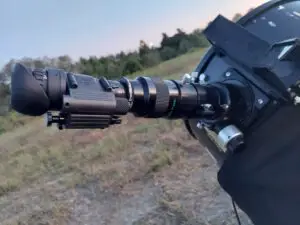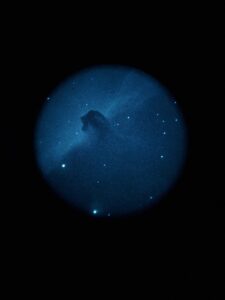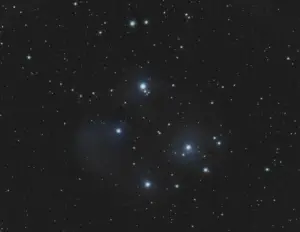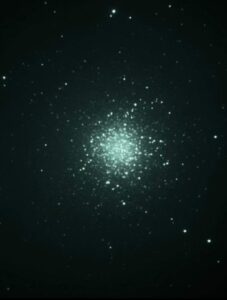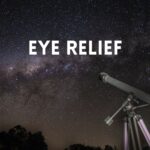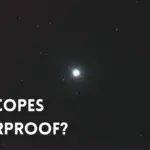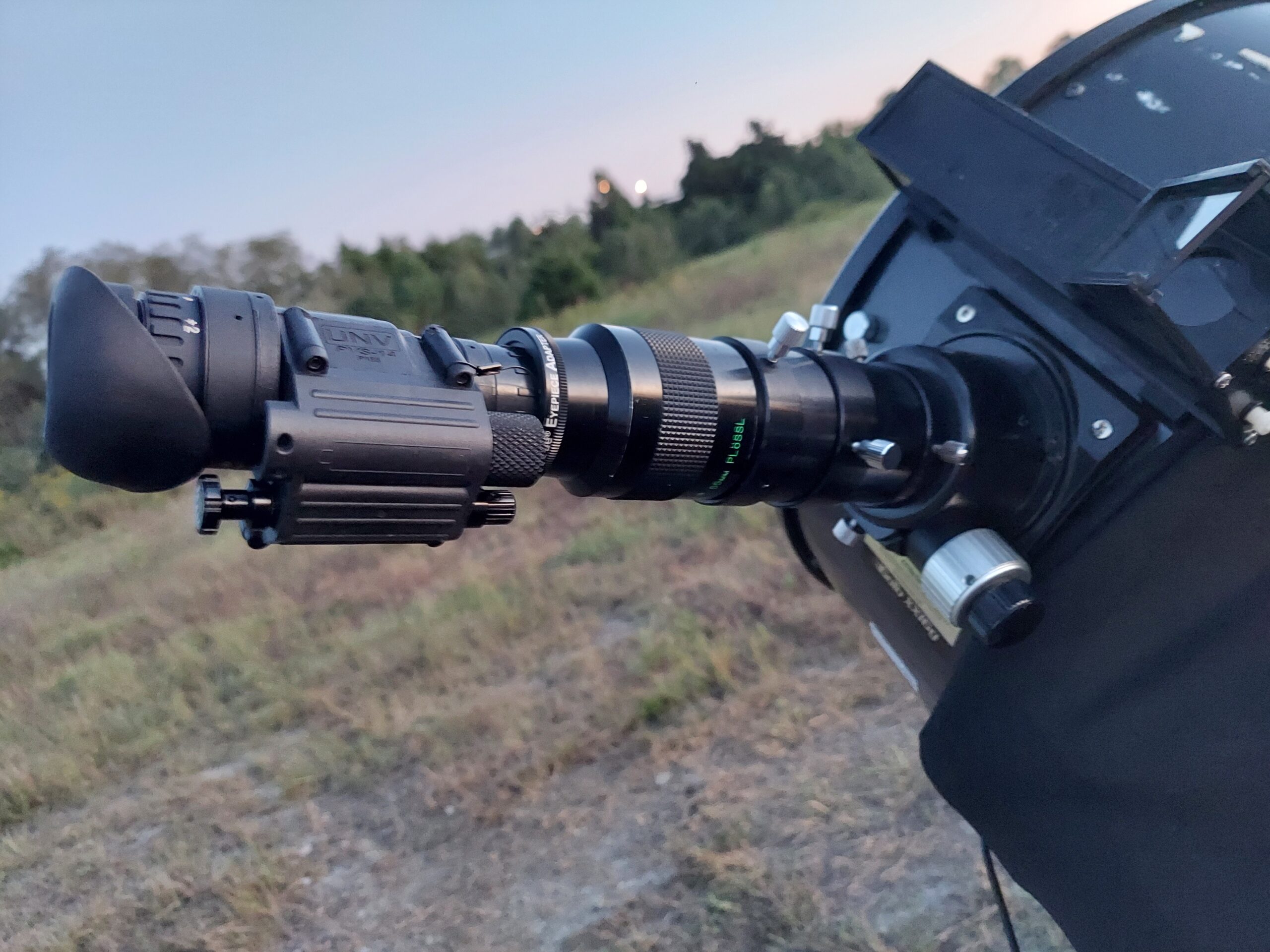Understanding exit pupil can help you when using your telescope and shopping for eyepieces and binoculars. Exit pupil is an important but underappreciated topic in astronomy.
Everyone is familiar with the concept of an entrance pupil. This is the black circle in the middle of your eye, the visible aperture through which light enters.
In an optical system, the exit pupil is a small circle of light which is projected from the eyepiece. This circle of light reaches the smallest diameter at a certain distance in front of the eyepiece’s eye lens, where the rays of light converge before diverging again. This distance is known as eye relief.
Looking into a telescope eyepiece is not the same as looking at a little TV screen.
Look through an eyepiece at arms length from your eye. What do you notice?
It is mostly dark. Even if it is pointed at a bright object like the moon.
Only the exit pupil will appear bright.
When you look through a telescope, you are aligning the exit pupil of the eyepiece with the entrance pupil of your eye. When you do this successfully, the view from the telescope fills your vision.
To experience the full field of view from an eyepiece, your eye must be centered on the exit pupil and positioned the correct distance.
This takes practice.
When someone looks into a telescope and can’t see anything, it is often because they are not lined up with the exit pupil (or the dust cap is on).


A comparison of two exit pupils from the same telescope. Left is 4.4mm, right is 1.5mm. They appear off-center due to the angle from which I’m viewing them.
If you’ve ever tried shooting through an eyepiece with a cell phone camera, you have probably noticed how hard it is to get a clear shot. This is because the exit pupil must be aligned with the tiny camera lens, at the correct distance, and without tilting.
The camera lens is so much smaller than your eye so lining them up is just very difficult.
Exit Pupil and Magnification
Newcomers to this hobby focus a lot on magnification: How much magnification do I need? What magnification does this or that eyepiece provide? What is the maximum magnification I can get with my telescope?
A better question might be: What exit pupil size should I aim for? As you’ll see in this section, the exit pupil size can tell you more than a magnification figure alone.
The size of the exit pupil depends on the focal ratio of your telescope and the focal length of your eyepiece. As magnification increases, the exit pupil gets smaller, and vice versa. The minimum and maximum useful magnification for any telescope will always be determined by the size of the exit pupil.
To calculate your exit pupil size, use the following formula: Eyepiece focal length/telescope focal ratio=exit pupil.
So, a 20mm eyepiece in an f/5 telescope will provide a 4mm exit pupil (20/4=5).
Another way to express this is: Telescope aperture (mm)/magnification=exit pupil.
The range of useful magnifications for a telescope are determined by its aperture. In other words, what is considered “high power” for a small telescope may be “medium power” for a large scope.
The main benefit of having a large-aperture telescope is allowing you to use more magnification while maintaining a moderate exit pupil size.
The overall usable range of exit pupil size is 0.5mm-7.0mm, give or take, but most observing is usually done somewhere in the middle of this range.
Let’s take a closer look at the relationship between magnification and exit pupil size.
Note that these figures are guidelines only, and are not written in stone:
High power: Exit pupils between 0.5-1.5mm.
- Useful for splitting double stars, observing fine planetary detail, and resolving compact planetary nebulae.
- At very high power, images become dim, subject to blurring due to poor seeing and diffraction.
- Eyeball floaters and dust on your optics may also become annoyingly visible. For these reasons, many seasoned observers don’t like to use exit pupils smaller than 1mm.
Note that on a 4-inch scope, a 0.5mm exit pupil equals 200x magnification, whereas for my 12-inch Dobsonian this figure is 600x. In practice, however, Earth’s turbulent atmosphere usually limits magnification to 300x or less.
Medium power: 1.5-3.0mm.
- This is the range that experienced observers tend to use most, as it provides a good balance between brightness and contrast while avoiding the issues of blurring and floaters.
- Medium magnifications are useful for all kinds of deep-sky objects, from open clusters to galaxies.
Low power: Over 3mm.
- The upper size limit depends on the age of the observer; the pupil of a child’s eye may dilate to 8mm when dark-adapted, but for someone over fifty this is more like 5mm.
- If the exit pupil is larger than the entrance pupil of your eye, you will lose light-gathering power exactly as if you put an aperture stop on your telescope.
- Low magnifications are favored for rich-field views of star fields and large clusters, and also for object locating.
- They provide the brightest image overall, in addition to viewing comfort. Many observers consider 4-5mm as the ideal range for low-power observing.
| Telescope | 20mm eyepiece | 10mm eyepiece | 5mm eyepiece | |
| 80mm f/5 | Magnification | 20x | 40x | 80x |
| Exit pupil | 4mm | 2mm | 1mm | |
| 150mm f/10 | Magnification | 75x | 150x | 300x |
| Exit pupil | 2mm | 1mm | 0.5mm | |
| 300mm f/5 | Magnification | 75x | 150x | 300x |
| Exit pupil | 4mm | 2mm | 1mm |
This chart gives examples of the relationship between exit pupil size and magnification for a few telescopes. Note that the largest telescope gives the same exit pupil as the small one, but at higher magnification. It also gives the same magnification as the medium scope, but with a larger exit pupil.
It is important to note that exit pupil alone tells you nothing about magnification and field of view; two telescopes may have the same exit pupil while providing completely different views.
Exit pupil is most useful for selecting eyepieces for a given telescope, or for working out the useful magnification range for a given telescope.
Exit Pupil and Binoculars
The rules are much the same for binoculars as for telescopes when it comes to calculating exit pupil.
The main difference is that binoculars usually have fixed magnification (that is, you cannot change the eyepieces). This means that a pair of binoculars will always provide the same exit pupil.
Binocular specifications are typically expressed as Magnification x Objective diameter (e.g., 7×50, 8×42, etc.). To calculate the exit pupil, you simply divide the objective diameter by the magnification.
This calls into question the oft-expressed opinion that 7×50 is the ideal pair, as this provides an exit pupil slightly larger than 7mm.
A 10×50 pair would give a more pleasing view with its 5mm pupil, but there is a trade-off: at 10x magnification, the view becomes shaky and difficult to hold steady by hand. This, of course, can be mitigated by using a tripod.

In any case, this explains why we don’t see low-power, large-aperture binoculars on the market.

